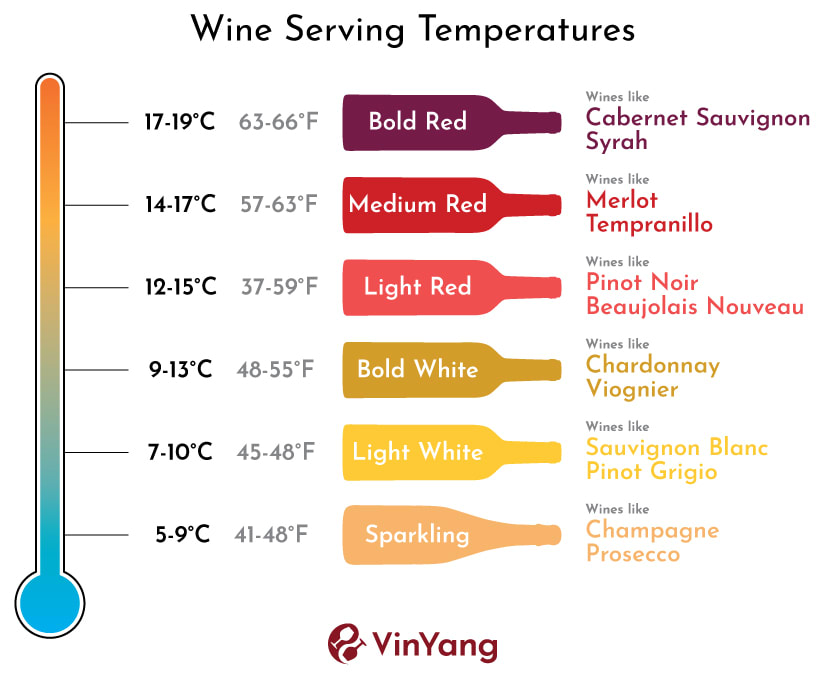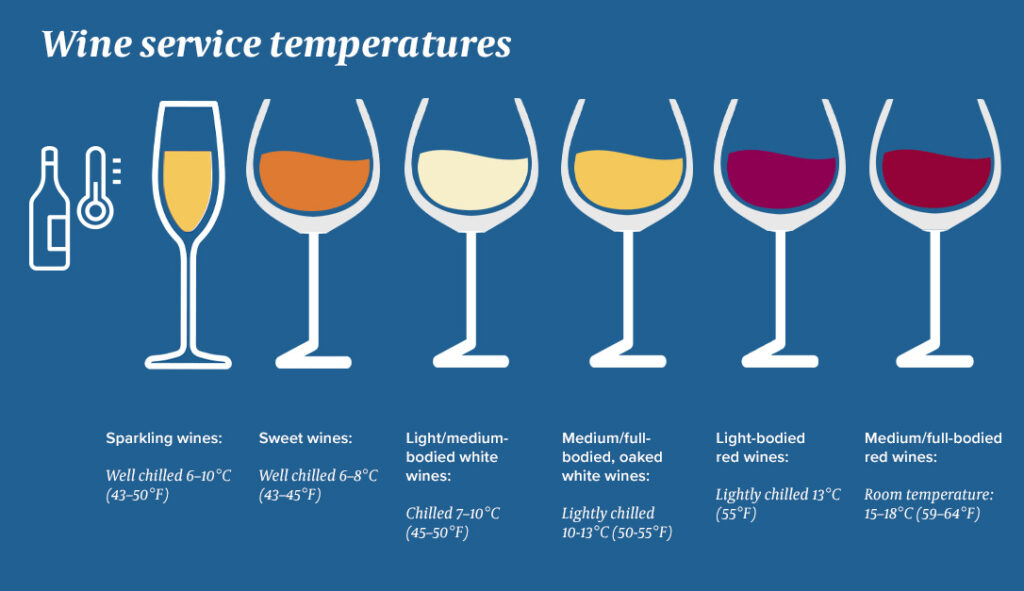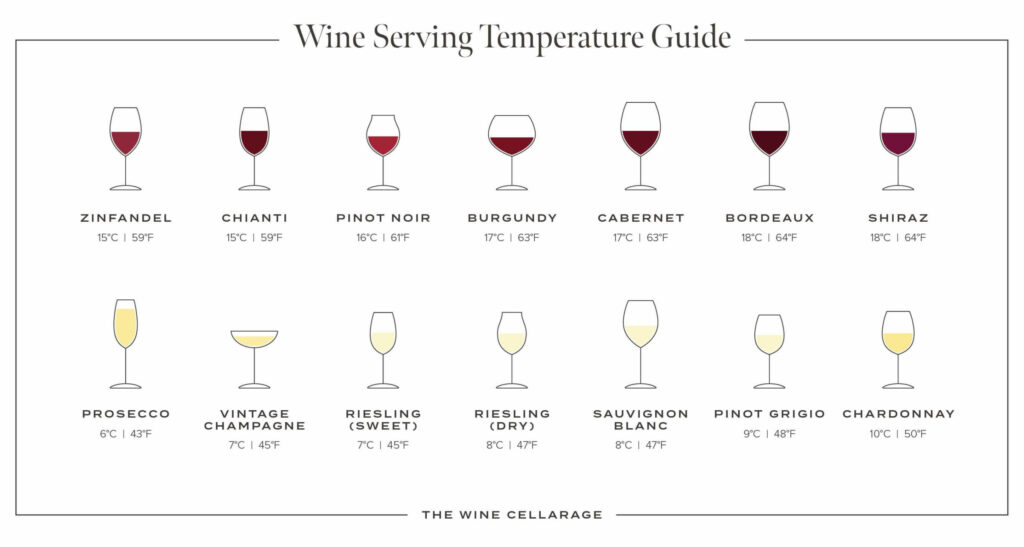
Whether you’re a wine enthusiast or just starting to appreciate the complexities of a good glass of wine, understanding the ideal storage temperature is essential to ensure that your favorite bottle reaches its full potential. In this article, we explore the importance of temperature when it comes to storing different types of wines. From delicate whites to robust reds, we’ll delve into the specific temperature ranges that will help you maintain the quality and taste of your cherished wines. So grab a glass, sit back, and let’s explore the fascinating world of wine storage temperature together.

Ideal Temperature for Wine Storage
When it comes to wine storage, temperature plays a crucial role in determining the quality and taste of your precious bottles. Whether you are a casual wine enthusiast or a serious collector, knowing the ideal temperature for storing different types of wines is essential. In this article, we will explore the optimal temperature ranges for various wine varieties, as well as the factors that can affect wine storage temperature.
White Wines
White wines are known for their delicate flavors and aroma. To preserve their freshness and crispness, it is recommended to store white wines at a temperature between 45°F (7°C) and 50°F (10°C). This temperature range allows the wine to age gracefully without compromising its delicate characteristics. It is important to note that storing white wines at temperatures higher than 50°F (10°C) can lead to premature aging and a loss of flavor.
Red Wines
Red wines, on the other hand, require slightly higher temperatures for optimal storage. The ideal temperature range for red wines is between 55°F (13°C) and 60°F (15.5°C). This temperature range allows the red wines to develop complex flavors and aromas over time. Storing red wines at temperatures below 55°F (13°C) can cause the wine to become dormant, while temperatures above 60°F (15.5°C) can accelerate the aging process and result in a flat taste.
Sparkling Wines
Sparkling wines, such as Champagne and Prosecco, have their own unique temperature requirements. These wines are best enjoyed when chilled, so storing them at temperatures between 40°F (4°C) and 45°F (7°C) is ideal. The low temperature preserves the bubbles and crispness of the wine, ensuring a delightful effervescence when uncorked. It is important to avoid storing sparkling wines at temperatures higher than 45°F (7°C) as it can result in the loss of carbonation.
Fortified Wines
Fortified wines, such as Port and Sherry, have a higher alcohol content compared to other wine varieties. These wines benefit from being stored at a slightly higher temperature range of 60°F (15.5°C) to 65°F (18°C). The higher temperature helps the fortified wines to develop and mellow out over time, enhancing their rich and complex flavors. Storing fortified wines at temperatures lower than 60°F (15.5°C) can hinder their aging process and diminish their desired characteristics.
Rosé Wines
Rosé wines offer a refreshing and vibrant drinking experience. To keep these wines at their best, they should be stored at a temperature range of 45°F (7°C) to 50°F (10°C). This temperature range allows rosé wines to maintain their delicate balance between fruity and floral notes while preserving their bright and crisp acidity. Avoid storing rosé wines at temperatures above 50°F (10°C) as it can result in a loss of freshness.
Dessert Wines
Dessert wines, like Ice Wine and Sauternes, are known for their intense sweetness and complex flavors. To preserve their unique characteristics, it is recommended to store dessert wines at a lower temperature range of 40°F (4°C) to 45°F (7°C). The cooler temperature helps to retain the wine’s sweetness and balance, ensuring a pleasurable sensory experience with every sip. Storing dessert wines at higher temperatures can cause the sugar to crystallize and impact the overall quality.
Aged Wines
Aged wines, whether white or red, require careful temperature control for optimum aging. The ideal temperature range for aging wines is between 55°F (13°C) and 60°F (15.5°C). This temperature range allows the wine’s flavors and aromas to develop gradually and harmonize over time. It is important to note that variations of a few degrees within this range won’t have a significant impact on the aging process. However, drastic temperature fluctuations can damage the delicate balance of aged wines.
Young Wines
Young wines, which are intended to be consumed within a few years of their release, do not require long-term aging. For these wines, it is recommended to store them at a slightly cooler temperature range of 50°F (10°C) to 55°F (13°C). This temperature helps to preserve the wine’s freshness and youthful characteristics. Storing young wines at higher temperatures can cause them to age prematurely, resulting in a loss of fruitiness and vibrancy.
Half-bottles and Magnums
Half-bottles and magnums, which are smaller and larger wine bottle sizes, have slightly different temperature requirements compared to standard 750ml bottles. For half-bottles, it is best to store them at the same temperature as their regular counterparts. However, for magnums, it is recommended to store them at a slightly higher temperature range of 60°F (15.5°C) to 65°F (18°C). The larger volume requires a higher temperature to ensure proper aging and development.
Mixed Cases
If you have a collection of various wine types and sizes, storing them together in a mixed case can be a convenient solution. When it comes to mixed cases, it is generally advised to store them at a temperature range between 55°F (13°C) and 60°F (15.5°C). This temperature range allows for a compromise that accommodates the different wine varieties and sizes. However, it is important to remember that some wines may benefit from individual storage conditions based on their specific requirements.
Factors Affecting Wine Storage Temperature
Apart from the recommended temperature ranges for different wine types, there are several factors that can affect wine storage temperature. Understanding these factors can help you maintain the ideal conditions for storing your wines and prevent any potential damage.
Chemical Reactions
Wine is a delicate beverage that can undergo chemical reactions when exposed to extreme or fluctuating temperatures. These reactions can impact the overall quality and taste of the wine. By storing wines at the recommended temperature ranges, you can minimize the risk of chemical reactions and ensure consistent flavors and aromas.
Wine Aging
Proper wine aging requires a stable and controlled environment. Temperature plays a vital role in the aging process, as it influences the rate at which the wine matures. Higher temperatures can accelerate aging, resulting in wines that may become overripe or develop off-flavors. On the other hand, lower temperatures can slow down the aging process, leading to wines that may lack complexity and depth. Maintaining a consistent temperature ensures a balanced and gradual aging of your wines.
Light Exposure
Exposure to light, particularly ultraviolet (UV) rays, can be detrimental to wine. UV rays can degrade the wine’s flavors and prematurely age it. Therefore, it is recommended to store wines in a dark environment or in bottles that offer UV protection, such as tinted glass. By protecting your wines from light exposure, you can maintain their quality and preserve their intended flavors.
Humidity Levels
Humidity levels can also impact wine storage, specifically the condition of the cork. Corks can dry out if exposed to low humidity, leading to air seepage and potential oxidation of the wine. Conversely, high humidity can promote mold growth and label damage. It is advisable to store wines in an environment with a humidity level between 50% and 70% to ensure the proper moisture content of the corks and preserve the wine’s integrity.
Specific Temperature Recommendations for Wine Storage
To summarize the optimal temperature ranges for different wine types:
- White Wines: 45°F (7°C) to 50°F (10°C)
- Red Wines: 55°F (13°C) to 60°F (15.5°C)
- Sparkling Wines: 40°F (4°C) to 45°F (7°C)
- Fortified Wines: 60°F (15.5°C) to 65°F (18°C)
- Rosé Wines: 45°F (7°C) to 50°F (10°C)
- Dessert Wines: 40°F (4°C) to 45°F (7°C)
- Aged Wines: 55°F (13°C) to 60°F (15.5°C)
- Young Wines: 50°F (10°C) to 55°F (13°C)
- Half-bottles and Magnums: Same as standard bottle sizes (magnums can be stored at a slightly higher temperature range of 60°F to 65°F)
- Mixed Cases: 55°F (13°C) to 60°F (15.5°C)
Other Considerations for Wine Storage
In addition to maintaining the proper temperature for wine storage, there are a few other important considerations to keep in mind.
Consistency in Temperature
Consistency is paramount when it comes to wine storage. Fluctuations in temperature can negatively impact the aging process and overall quality of the wine. It is crucial to avoid sudden temperature changes or exposure to extreme heat or cold. Choose a storage location that maintains a consistent temperature to ensure the long-term preservation of your wine collection.
Avoiding Temperature Fluctuations
Temperature fluctuations, even within the recommended temperature ranges, can disturb the wine inside the bottle. These fluctuations can cause the wine to expand and contract, potentially leading to leaks or seepage through the cork. It is advisable to choose a storage space that minimizes temperature variations to maintain the wine’s quality and prevent potential damage.
Avoiding Extreme Temperatures
Extreme temperatures, whether excessively hot or cold, can ruin your wine. Frequent exposure to high temperatures can cause the wine to age rapidly and develop off-flavors. Similarly, freezing temperatures can lead to the expansion of wine and subsequent bottle breakage. It is crucial to avoid storing wine in areas that are subject to extreme temperatures, such as attics, garages, or basements without temperature control.
Best Practices for Wine Storage
To ensure the optimal conditions for storing your wine collection, consider the following best practices:
Wine Storage Units
Investing in a wine storage unit or wine refrigerator can provide you with a dedicated space to store your wines. These units are designed specifically for wine storage, taking into account factors such as temperature, humidity, and light exposure. They come in various sizes and capacities, allowing you to choose one that suits your collection’s needs.
Temperature Control
Regardless of the storage solution you choose, temperature control is a vital aspect of wine storage. Ensure that the storage unit or space you use allows you to set and maintain the desired temperature consistently. Some wine storage units offer adjustable temperature settings, allowing you to customize the storage conditions based on the wine types you possess.
Wine Racks and Shelves
If you prefer a more hands-on approach, wine racks and shelves can be an excellent storage solution. These racks and shelves come in different sizes and configurations, accommodating various bottle sizes and quantities. Place the racks or shelves in a location that is away from direct sunlight and maintain a consistent temperature around them.
Wine Cellars and Cabinets
For wine collectors with larger collections, wine cellars or cabinets provide an impressive and efficient storage solution. These dedicated storage spaces are designed to replicate the environment found in traditional wine cellars. Wine cellars typically offer temperature and humidity control, as well as storage options for different bottle sizes and quantities.
Professional Storage Facilities
If you lack the space or resources to create a dedicated wine storage area at home, professional wine storage facilities can be an excellent alternative. These facilities offer secure and climate-controlled environments specifically designed for storing wine collections. They provide optimal conditions for aging and preserving wines, taking the hassle out of maintaining your collection.

Conclusion
In conclusion, the ideal temperature for wine storage varies depending on the type of wine. White wines, red wines, sparkling wines, fortified wines, rosé wines, dessert wines, aged wines, young wines, half-bottles, and magnums each have their own recommended temperature ranges. Factors such as chemical reactions, wine aging, light exposure, and humidity levels can also affect wine storage. To ensure the best possible storage conditions for your wines, maintaining consistency, avoiding temperature fluctuations, and steering clear of extreme temperatures are crucial. By following the best practices and considering the various storage options available, you can safeguard your wine collection and enjoy the rich flavors and aromas of each bottle to their fullest potential.

